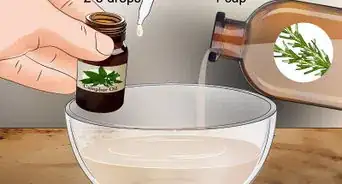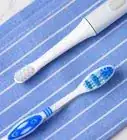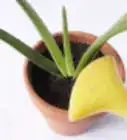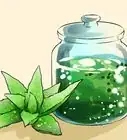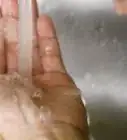This article was co-authored by wikiHow staff writer, Amber Crain. Amber Crain has been a member of wikiHow’s writing staff for the last six years. She graduated from the University of Houston where she majored in Classical Studies and minored in Painting. Before coming to wikiHow, she worked in a variety of industries including marketing, education, and music journalism. She's been a radio DJ for 10+ years and currently DJs a biweekly music program on the award-winning internet radio station DKFM. Her work at wikiHow supports her lifelong passion for learning and her belief that knowledge belongs to anyone who desires to seek it.
The wikiHow Video Team also followed the article's instructions and verified that they work.
This article has been viewed 310,410 times.
Learn more...
Commercially available shampoos are often filled with synthetic chemicals. These chemicals can cause allergic reactions and some are potentially harmful to the environment. As a result, many people have turned to homemade recipes to safely and naturally cleanse their hair. Aloe vera, a succulent plant prized for its skin-soothing properties, is a popular base for homemade shampoos. Aloe vera can gently cleanse the hair and scalp while also conditioning dry and damaged hair. It may also stimulate hair growth.
Ingredients
Natural Aloe Vera Shampoo[1]
- 2 cups (475 milliliters) distilled water
- 6 ounces (180 milliliters) liquid castile soap
- 2 tablespoons (30 milliliters) aloe vera gel
- ½ teaspoon (2.5 milliliters) jojoba oil
- 40 to 50 drops essential oils (optional)
- 2 ounces (56 grams) dried herbs (optional)
Yield: About 3 cups (710 milliliters or 24 fluid oz) of shampoo
Steps
Assembling the Ingredients
-
1Obtain organic aloe vera gel from a health or natural medicine shop. Commercially available aloe vera gel is sold in bottles and they come in varying degrees of purity. Many of these commercial products contain additives and chemicals. Since you’ll be using this shampoo directly on your hair and scalp, it’s best to get the purest aloe vera gel you can find. Check the label and ingredients before you buy a product. Make sure it’s certified organic and labelled as “pure.”
- If it lists any chemical names or alcohol as ingredients, look for a different brand.
- You can buy aloe vera gel at most grocery stores, but these tend to be the less pure versions. A health or natural medicine shop is the best place to obtain pure aloe vera gel that is certified organic.
-
2Harvest aloe vera gel directly from the plant. Harvesting the fresh gel from an aloe plant will provide the most beneficial results. If you don’t grow aloe vera in your home, consider buying a few plants. To harvest the gel, start by cutting off one full leaf from the plant. Slice the leaf open length-wise and pull apart the two halves. Scoop out the thick, translucent gel with a spoon.[2]
- Spoon the fresh gel into a clean bowl nearby.
- You only need 2 tablespoons (30 milliliters) of fresh gel, which you can harvest quickly and easily. It will only take a few aloe vera leaves to provide that amount.
Advertisement -
3Use dried herbs for additional benefits (optional).[3] Aloe vera gel is a great moisturizer and can naturally promote hair growth.[4] It’s a great carrier if you want to include natural herbs for added benefits. You can use any combination of the following dried herbs, as needed, as long as you don’t use more than 2 ounces (56 grams) total.
- For dry hair use nettle, burdock, rosemary or calendula.
- For oily hair use yarrow, lavender, lemon balm or mint.
- If you have blonde hair try calendula or chamomile.
- If you have dark hair try sage or comfrey.
- To combat dandruff try rosemary, thyme or any of the herbs for dry hair.
-
4Use essential oils for scent and additional benefits (optional). Essential oils are concentrated extracts from natural plants. Many of them smell nice and others may have medicinal properties. There are quite a few essential oils that can benefit the health of your hair and scalp. You can use any combination of the following oils in your shampoo, but do not use more than 50 drops total.[5]
- For normal hair use lavender, clary sage or chamomile.
- For oily hair use lemon, tea tree or ylang-ylang.
- For dry hair try rosemary, myrrh or peppermint.
- To combat dandruff try tea tree, patchouli or lavender.[6]
- Never use essential oils directly on your scalp, since they are highly concentrated and extremely potent. In this case, the other ingredients in the shampoo will safely dilute the oils.
Creating the Shampoo
-
1Bring the distilled water to a boil. Measure out 2 cups (475 milliliters) of distilled water. Pour the water into a pot. Place the pot on a stove burner over high heat. Bring the water to a rolling boil.[7]
- If you're not using dried herbs, there is no need to boil the distilled water. You will mix the ingredients together as is.
-
2Add the dried herbs of your choice. If you’re using any dried herbs in your shampoo, measure them out now. Remember, don’t use more than 2 ounces (56 grams) total. When the water begins to boil, carefully add the herbs to the pot.[8]
-
3Cover the pot and reduce the heat to low. After you add the dried herbs, put a lid on the pot. Reduce the heat to low. This will infuse the water with the herbs. Allow the herbs to steep in the simmering water for 15 to 20 minutes.[9]
-
4Remove the pot from heat and strain out the herbs. Turn off the burner and remove the lid from the pot. Be careful, since hot steam will probably rise up after you remove the lid. Place a large bowl beneath a strainer.
-
5Pour the hot water carefully through the strainer. The spent herbs will remain behind as the infused water goes into the bowl. After you strain the spent herbs out of the water, discard the remains.
-
6Add the castile soap to the herbal water. Measure out 6 ounces (180 milliliters) of liquid castile soap. Slowly pour the soap into the bowl with the infused water. Mix the substances together gently as you pour in the soap. The water is probably still very hot, so be careful not to splash.[10]
-
7Add the aloe vera gel, jojoba and essential oils. Measure out and add 2 tablespoons (30 milliliters) of aloe vera gel and ½ teaspoon (2.5 milliliters) of jojoba oil. Carefully add them to the bowl one at a time, stirring constantly. Mix the ingredients together well.
- If you are using essential oils, add them now. Remember, don’t use more than 40 to 50 drops of the essential oils. Stir well.[11]
Bottling, Using and Storing the Shampoo
-
1Bottle the shampoo mixture. Use a funnel to carefully pour the shampoo mixture into a plastic or glass container that will hold about 3 cups (710 milliliters or 24 fluid ounces) of liquid. If you used plain water and did not infuse the shampoo with dried herbs, you can safely store the entire bottle in your shower.[12]
-
2Store the bottle in the refrigerator if you used dried herbs. If you infused the water with dried herbs, you must store the bottle in the refrigerator. It will go bad if left out at room temperature for more than one or two days. It will last for about 10 days in the refrigerator. Around the 10 day mark, be sure to smell the mixture before using it.[13]
- If it smells sour, throw it out and make a new batch. If it smells good, the shampoo is still usable.
- For convenience, you can transfer some of the shampoo to a small bottle and keep that in your shower for one or two days without it going bad.
-
3Use the shampoo as needed. Aloe vera shampoo is gentle enough to use every time you wash your hair. Always shake the bottle gently before you use the shampoo, since the ingredients can settle over time. Pour a quarter-sized amount into your palm and massage it into your hair and scalp. Rinse thoroughly.[14]
Expert Q&A
-
QuestionCan you use aloe vera by itself on hair?
 Shun PittmanShun Pittman is a Master Cosmetologist, Author, Owner, and Founder of Corps d’Elite Salon and Corps d’Elite Beauty. With over 25 years of international experience, she is dedicated to and specializes in providing luxury salon services to all hair types and textures and every skin tone and shade. Her services include hair conditioning treatments, cutting, coloring, styling, extensions, and makeup application. Shun has experience working with, coaching, training, and mentoring beauty professionals from multiple companies including L'Oréal, Wella, Matrix, Paul Mitchell, Redken, Big Sexy Hair, and Toni & Guy. She is also a host for national and local media outlets and her work has been featured in The Washingtonian, The Cheddar Network, and WJLA Good Morning Washington's Beauty and Fashion Police segments. Shun is the author of “50 Things Your Hairdresser Wants YOU to Know (and a few things we don’t...)".
Shun PittmanShun Pittman is a Master Cosmetologist, Author, Owner, and Founder of Corps d’Elite Salon and Corps d’Elite Beauty. With over 25 years of international experience, she is dedicated to and specializes in providing luxury salon services to all hair types and textures and every skin tone and shade. Her services include hair conditioning treatments, cutting, coloring, styling, extensions, and makeup application. Shun has experience working with, coaching, training, and mentoring beauty professionals from multiple companies including L'Oréal, Wella, Matrix, Paul Mitchell, Redken, Big Sexy Hair, and Toni & Guy. She is also a host for national and local media outlets and her work has been featured in The Washingtonian, The Cheddar Network, and WJLA Good Morning Washington's Beauty and Fashion Police segments. Shun is the author of “50 Things Your Hairdresser Wants YOU to Know (and a few things we don’t...)".
Master Cosmetologist, Global Salon Educator & Author I first recommend people do a 24-hour patch test. To do this, first clean either the inside of your elbow or behind your ear with warm, soapy water. Then pat it dry and apply aloe vera. Next, wait 24 hours to see if you have an allergic reaction. Typically people will see a reaction within two hours but the 24-hour window is a smart approach. If you have an allergic reaction, don't use it. If you can use it, I recommend first doing a good cleansing and then apply the aloe vera on the scalp. Do a great massage to get the blood pumping. Then let it process for 10 or 15 minutes. Finally, thoroughly rinse it out of the hair, apply your favorite conditioner, rinse and proceed with your regular styling routine.
I first recommend people do a 24-hour patch test. To do this, first clean either the inside of your elbow or behind your ear with warm, soapy water. Then pat it dry and apply aloe vera. Next, wait 24 hours to see if you have an allergic reaction. Typically people will see a reaction within two hours but the 24-hour window is a smart approach. If you have an allergic reaction, don't use it. If you can use it, I recommend first doing a good cleansing and then apply the aloe vera on the scalp. Do a great massage to get the blood pumping. Then let it process for 10 or 15 minutes. Finally, thoroughly rinse it out of the hair, apply your favorite conditioner, rinse and proceed with your regular styling routine.
References
- ↑ https://bellatory.com/hair/Aloe-Vera-Shampoo
- ↑ https://bellatory.com/hair/Aloe-Vera-Shampoo
- ↑ https://bellatory.com/hair/Aloe-Vera-Shampoo
- ↑ https://www.organicfacts.net/health-benefits/herbs-and-spices/health-benefits-of-aloe-vera.html
- ↑ https://bellatory.com/hair/Aloe-Vera-Shampoo
- ↑ http://www.naturallivingideas.com/essential-oils-for-hair/
- ↑ https://bellatory.com/hair/Aloe-Vera-Shampoo
- ↑ https://bellatory.com/hair/Aloe-Vera-Shampoo
- ↑ https://bellatory.com/hair/Aloe-Vera-Shampoo
About This Article
To make aloe vera shampoo, bring 2 cups of distilled water to a boil, add 2 ounces of dried herbs, and let the mixture simmer for 15-20 minutes to infuse the water with the herbs. Next, strain out the herbs, add 6 ounces of liquid castile soap to the herbal water, and stir the ingredients together. Then, stir 2 tablespoons of aloe vera gel, ½ teaspoon of jojoba oil, and 40-50 drops of essential oil into the mixture. Finally, use a funnel to carefully pour the shampoo mixture into a plastic or glass container. For tips on storing your shampoo, read on!
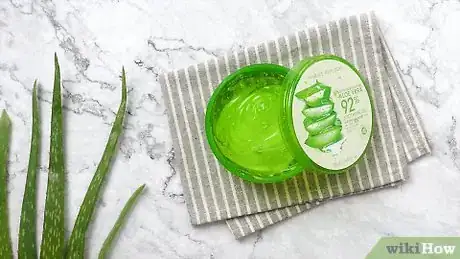

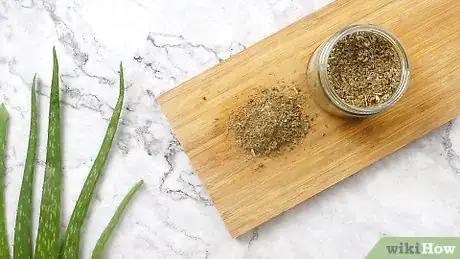


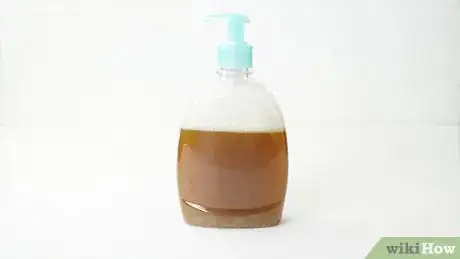

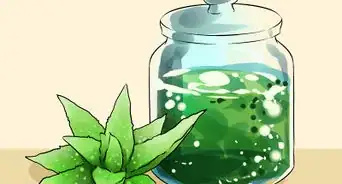

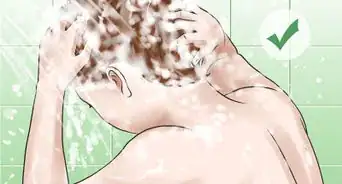

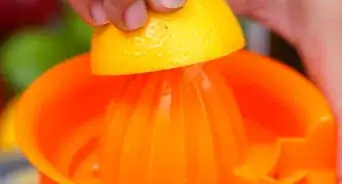
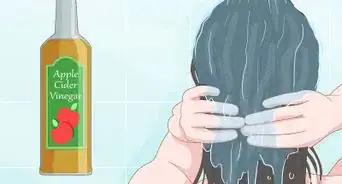
-Step-5.webp)

